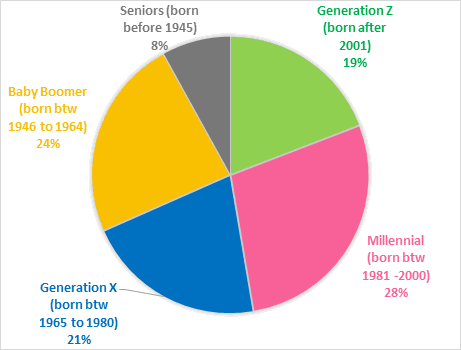| | The most distinctive change in the agri-food market over time has been the expansion of choices in the number and type of food and beverages available to consumers. This growth has been spurred mainly by advances in information and communication technology. In addition, trade liberalization, regulatory reforms, research and development have all contributed to this situation as well.
When product diversity increases, agri-food markets become more complex and competitive. To survive in this competitive market, agri-food business owners need to innovative. In this context, it is important to understand consumer trends. Therefore, this issue explains how to better understand the consumer and the tools that one can use to understand them. Some of the noteworthy consumer market trends are also presented to help innovators understand the current agri-food market.
Consumer trends in the context of innovation
There is a constant flow of new products and services into the market these days. In the context of innovation, a consumer trend is defined as “a new manifestation among people (in behavior, attitude or expectation) of a fundamental human need, want or a desire” (Trend Watching). In this situation, it is hard to draw a meaning behind some consumer trends. However, understanding consumer trends is important for success in agri-business. There are a number of established ways to understand your potential consumers.
Consumer surveys: A carefully designed survey can be used to ask consumers what they want. While this is a good way to understand consumers’ attitudes and perceptions about products and services, its use is limited and does not account for innovation because people usually do not know what they want next until they see something new. The major drawback to this method is that consumers do not always do what they claim they will do in a survey.

Ethnographic studies: In this method, researchers observe consumers in the field and try to understand them to develop deep insights on what consumers want. The findings of this method are more reliable than the survey method. However, conducting ethnographic studies is slow and expensive since a lot of human resources are needed.

Big data: The data collected through social media, search engines and scanner data all provide valuable information on consumer preferences. It is a great source for understanding what consumers are actually purchasing and how the market is really behaving. A challenge with this method is that given the sheer volume of information, a certain level of analytical capacity and expertise is needed to make sense of all the data. Additionally, the cost of obtaining this information or data is very high.
Watch/follow innovations: According to Trend Watching, this new methodology emphasizes the importance of looking at and analyzing innovations in the market. According to this model, although, our world is changing rapidly in terms of technology, environment and socio-economic conditions; the fundamental needs of human beings do not change much over time. Normally, big innovators use external changes to unlock a new way to serve a human need or want. These innovations then create new trends along with new customer expectations. For example, innovations in the food industry such as; drive-through restaurants, ready to eat meal offerings in grocery stores and healthy snacking options, all create new consumer expectations and new consumer trends.
Noteworthy Consumer Market Trends
Changing Demographics
In a fast-paced world, socio-demographic information is most useful in identifying and predicting consumer trends. Population trends and the composition of population, in terms of generations and ethnicities, provides useful information in understanding consumers. For example, lifestyle differences between generations and their attitudes translates into distinct preferences and expectations when it comes to their food choices. Studies of different generations show that the aging population is driving health and wellness trends in the agri-food industry. The Millennial generation is made up of a variety of ethnic and cultural backgrounds and is driving trends around ethical food choices and sustainability. The youngest group, Generation Z is driving trends related to technology. Understanding generational differences along with their expectations and their potential in resulting trends can help agri-food businesses be successful innovators.
Profile of generations in Alberta, 2016

Source: Statistics Canada
Increasing ethnic diversity is another area that innovators should focus on. Southeast Asian and Filipino visible minorities are considerably higher in Alberta as compared to Canada as a whole. Alberta’s foreign born population represented 18 per cent of the province’s total population in 2011. Their lifestyle and food behaviors are shaping our industry as well. For example, various ethnic food habits have implications for food processors and producers. An increasing Muslim population has increased demand for halal meat which has created opportunities and challenges for Alberta’s Agri-food sector.
Health and Wellness Trends
Increased awareness of health and wellness has completely transformed food demand and shifted eating habits. The demand for specialty, natural and organic products remains strong and continues to generate high profits for food manufacturers. The “free from” food trend is growing. Trans fat free, sugar free, gluten free are examples of recent trends that have emerged and stayed in the marketplace. A number of functional foods targeted to various consumer groups are always in high demand. Plant-based food trends are also on the rise. Vegan (very strict vegetarian diets) and flexitarian diet (on and off type of vegetarian diets) trends can now be observed in the marketplace.
Consumers have been told about the benefits of eating breakfast. Recognizing this, fewer people are skipping this meal and consequently consumers are looking for more than bread and cereal. People are looking for protein-rich breakfast foods, including yogurt and nuts. Research has also found that “Meal Replacements” are overtaking weight loss supplements as a means of shortcutting weight loss. Increasing demand for gluten free, probiotics, and healthy snacks all create opportunities to be innovative.
With technological advances and innovations, personalized diets are set to gain in popularity. People will be able to scan their DNA to help develop a personalized diet. They can use on-line filters to assist them to choose between organic foods, reduced sodium items or products that will help lower their carbohydrate intake. These types of technological tools will be used by more consumers in the years ahead.
According to a recent research study, 33 per cent of Canadians are willing to pay a premium for health enhancing products indicating that there are opportunities to be innovative in a premium healthy food market. By 2031, twenty five per cent of Canadians will be over 65 years old. This means healthy eating trends will accelerate.

Sustainability Trends
Concerns about environmental sustainability is a mega trend that has been accelerating in recent years. Some examples include, consumers increased interest in a food product’s production such as; carbon footprint, water footprint, the presence and labeling of genetically modified organisms (GMOs), pesticide and herbicide use, organic certification and waste management.
Alternative and environmentally friendly ingredients such as macro algae (seaweed), micro algae (chlorella) and insects as protein trends are also based on this sustainability mindset. Recently, waste management has gained more consumer attention. People are concerned about the massive waste we create and the amount of energy, time and materials that are put into this waste. Due to this increased consumer scrutiny, product and service innovations around waste management and waste reduction can be expected.

Technological Trends
The skyrocketing use of smartphones among Canadian consumers and frequent social media use have created new trends that impact food markets. According to market research, nearly eighty per cent of Canadians owned a smartphone in 2016. This has created new customer expectations for convenience, authenticity and personalization and has challenged the way companies do business. On-line shopping will grow as consumers are looking to reduce time and energy spent shopping. Hand held food scanners inside the stores that allow users to get the nutritional value and ingredients of foods also appear set to rise in popularity. New wearable technologies, self-tracking apps to help consumers to ‘quantify’ and track data are also growing in use. The 3D printing technology will help consumers to personalize food with respect to nutritional value and ingredients, flavour, texture and size.
Life Style Changes
Changes in consumers’ lifestyles are a result of everything described in the foregoing. We see that lifestyle changes are largely centered on changing demographics. Changing consumer expectations are being driven by a shift in mindset around health and wellness, sustainability and convenience and that technological advances are helping to change consumers’ lifestyles rapidly.
What this means for you
- Undertaking consumer market research and understanding consumer trends is a key step towards successful innovation and investment in agri-business.
- There are a number of methods that can be used to better understand consumer trends.
- Changing demographics and changing mind-sets of consumers in terms of health and wellness, convenience and sustainability are creating many trends that agri-food producers and processors can capitalize on.
Reference
|
|